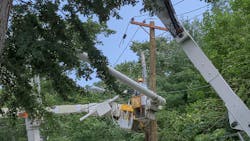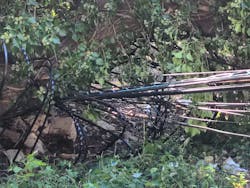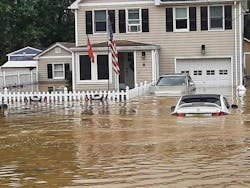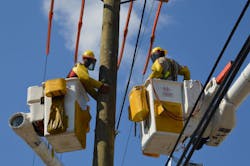Storm-Proofing Substations and Systems
Lights went dark for two million Public Service Electric & Gas (PSE&G) customers in the wake of Superstorm Sandy. Considered as the most destructive storm in the utility’s history, the storm surge flooded the company’s switching and substations with 4 ft to 8 ft of water.
The utility’s service territory, which lines the coast and borders rivers, was also blasted by two other severe weather events in a 14-month period—Hurricane Irene and a major snowstorm. Due to the magnitude of damage and power outages, PSE&G launched its Energy Strong 1 hardening program from 2013 to 2018.
“A big part of the program was raising substations or eliminating them to get them out of the flood plain,” said Ed Gray, director of transmission and distribution engineering at PSE&G. “Following Sandy, we raised or eliminated substations in major flood zones to at least the 100-year-flood level plus 1 ft. In areas where Sandy flooding exceeded 100-year-flood level, we raised it to the Sandy-flood level plus 1 ft.”
The field workforce elevated 26 substations and switching stations. They also transferred the load from small flood-prone substations to other facilities in the area. Since that time, the utility has been hit by heavy rain events from tropical storms and hurricanes. Its substations and infrastructure, however, have withstood major damage due to the US$1.22 billion Energy Strong hardening program.
“We have done a lot of work in that area, and the flooding risk is much different today than 10 years ago,” Gray said. “Even if we get water in the substations, we don’t have a major impact on important equipment.”
PSE&G also enhanced the remote capabilities of its substations installing a new SCADA system and upgrading to microprocessor feeder relays at 111 stations. This enabled both the remote indication and operations of circuit devices to enhance restorations efforts. In addition, the utility is converting to a wireless, high-speed communication system for pole mounted reclosers and installing redundant fiber communications between its substations. “We now have the ability to restore customers from different circuits and get power on more quickly for our critical customers,” Gray said.
Finally, in addition to the work to enhance substations, PSE&G worked with the local emergency management organizations to identify and harden or create redundant supplies to 260 critical facilities including hospitals, water treatment plants, etc.
Continuing to Make Improvements
PSE&G, which serves almost three-quarters of New Jersey’s population, is now forging ahead with its Energy Strong 2 program. For the last three years, the utility has performed sectionalizing on the system by installing pole-top reclosers and upgrading its advanced distribution management system. By integrating its GIS and OMS systems, PSE&G can more rapidly react to storms and boost its situational awareness.
PSE&G, which operates and maintains an extensive transmission underground system, is also upgrading its overhead transmission system from 138 kV to 230kV or 345 kV operation with the associated improvements to the supporting structures. The utility also began rewiring its system before Superstorm Sandy by adding 69-KV lines on stronger poles with better lightning protection and fiber optic wires for improved communication between substations.
With tree-related outages as one of the leading causes of power disruptions during storms, New Jersey adopted regulations in the high voltage (138 kV and above) transmission ROWs to remove any vegetation that has the potential to impact the circuit. Referred to integrated vegetation management, the practice allows for trees as long as they will not grow high enough to impact the lines.
“Our transmission system has held up well in major events, at least in part to our vegetation management program,” Gray said.
To further prevent vegetation-related outages, PSE&G is planning on upgrading open-wire circuits to spacer construction with a smaller profile and covered wire. Also, the utility has a team of certified arborists who oversee and outsource vegetation management work to contractors, who perform a four-year trimming program.
When severe storms hit, PSE&G can call upon the arborists to provide assistance. Following Sandy, PSE&G also expanded its network of mutual aid from eight to 22 utilities.
“When we have resources coming in to support us during a storm, I always have two questions: How many line crews do we have and how many tree trimmers? We need both,” said PSE&G Vice President, Electric Operations Jack Bridges. “Vegetation is a primary issue in a large event.”
Standing Strong Against Severe Storms
Due to PSE&G’s Energy Strong hardening program, the utility has been able to minimize outages from a series of storms starting in early summer and stretching into the fall. Over the last few months, multiple hurricanes raged into PSE&G’s service territory, namely Henri, Elsa and Ida. For example, Elsa knocked down large trees, branches and wires across New Jersey in early July. Line workers, tree trimmers, surveyors and other utility personnel were dedicated to the restoration effort, and by working around the clock, they quickly restored power to the more than 50,000 customers out of service by 11 a.m. on July 9.
Then Hurricane Henri drenched New Jersey and the Northeast in August. While Henri passed mostly east of New Jersey, PSE&G still experienced heavy rain and localized flooding from the tropical storm.
“Based on the latest track of Hurricane Henri, we expect high winds that can cause flying debris, and bring down trees and power lines as well as the potential for flooding in coastal areas,” Bridges said in advance of the storm.
Henri was followed by Hurricane Ida, which made landfall in New Orleans on the 16th anniversary of Hurricane Katrina. The Category 4 hurricane caused widespread destruction and a million outages in Louisiana. By the time it hit PSE&G’s service territory, the tropical storm caused flooding and storm damage, making it challenging for crews to make repairs. Still, more than 120,000 electric customers were restored by Sept. 4, with most back on the night before.
On Sept. 2, PSE&G reported that Ida brought an unprecedented amount of rain, causing extreme flooding conditions in its service territory. In turn, the utility dispatched gas crews to the hardest-hit areas to shut off natural gas and prevent gas emergencies for about 21,000 gas customers. Also, more than 1,200 line workers, tree trimmers, surveyors and other utility personnel worked together to restore power, clear vegetation and make repairs.
“We continue to work as safely and quickly as possible to address the many challenging conditions caused by Tropical Storm Ida and we understand how difficult this situation is for everyone,” Bridges said. “The safety of our employees and customers remains our highest priority and our thoughts and prayers go out to all who have been impacted by this storm.”
Restoring Power Safely
To stand up against severe weather events like the recent hurricanes and tropical storms, PSE&G regularly conducts storm drills. For example, PSE&G reviews mutual aid agreements and designates lay-down areas. Before the storm season hits, the employees must also fulfill annual training requirements, and the team reviews the emergency stock and preparedness program.
Like other utilities, however, PSE&G has had to adapt its safety protocols due to the ongoing COVID-19 pandemic. To maintain social distancing, the utility limits passengers in vehicles, and employees work from home whenever possible. On large-scale storm restoration events like Hurricane Isaias, the utility also assigned safety watchers to ensure the mitigation policies were being followed.
“We have taken the COVID-19 protocols extremely seriously right from the very beginning,” Gray said.
When responding to storms, safety is a top priority, he says. “If you are trying to get somewhere, and flooded roads are an issue, working safe and getting there is what matters,” he said. “For PSE&G, safety is an everyday thing. It’s all about preparation and identifying the hazards.”
Amy Fischbach ([email protected]) is the Field Editor for T&D World magazine.
About the Author
Amy Fischbach
Electric Utilities Operations
Amy Fischbach is the Field Editor for T&D World magazine and manages the Electric Utility Operations section. She is the host of the Line Life Podcast, which celebrates the grit, courage and inspirational teamwork of the line trade. She also works on the annual Lineworker Supplement and the Vegetation Management Supplement as well as the Lineman Life and Lineman's Rodeo News enewsletters. Amy also covers events such as the Trees & Utilities conference and the International Lineman's Rodeo. She is the past president of the ASBPE Educational Foundation and ASBPE and earned her bachelor's and master's degrees in journalism from Kansas State University. She can be reached at [email protected].




